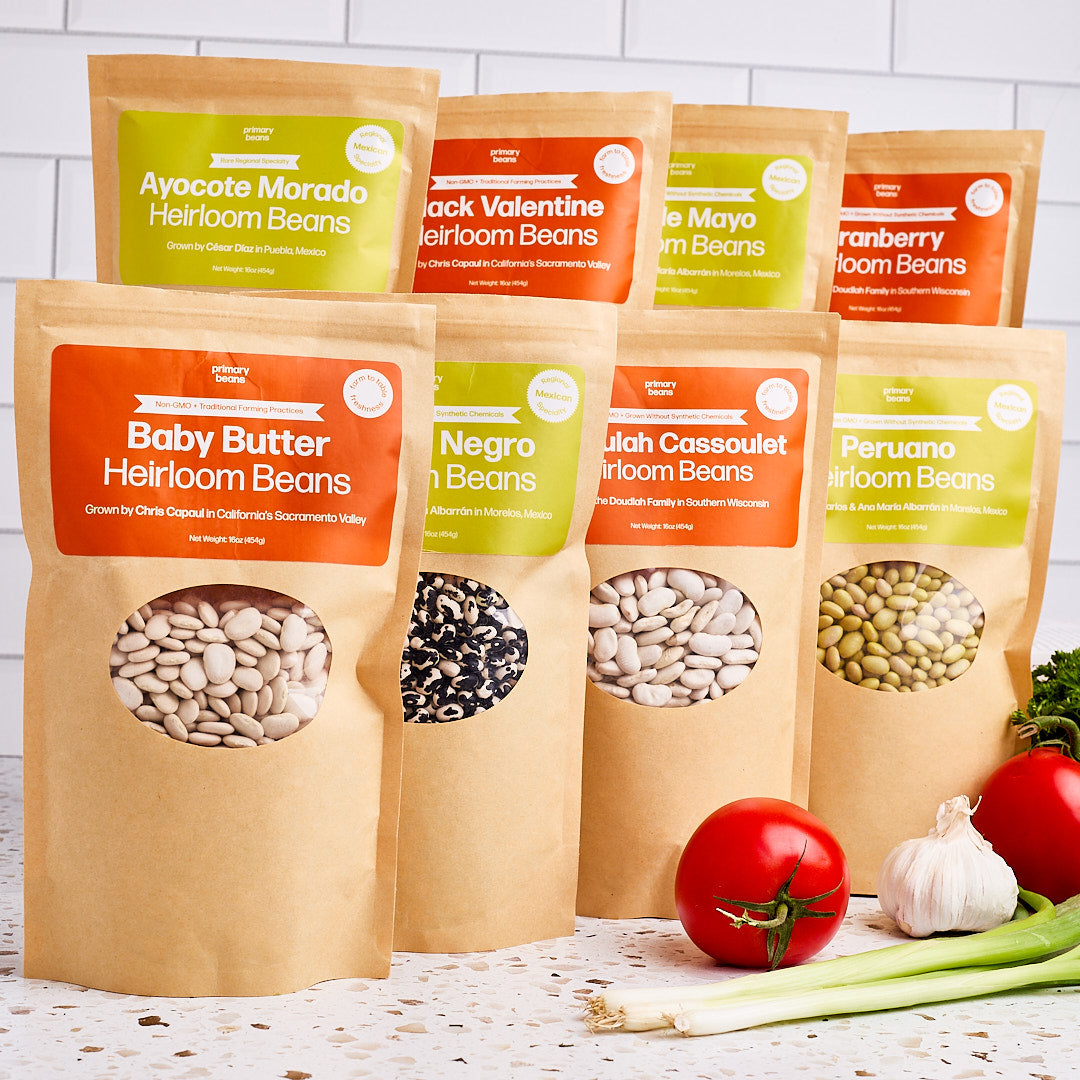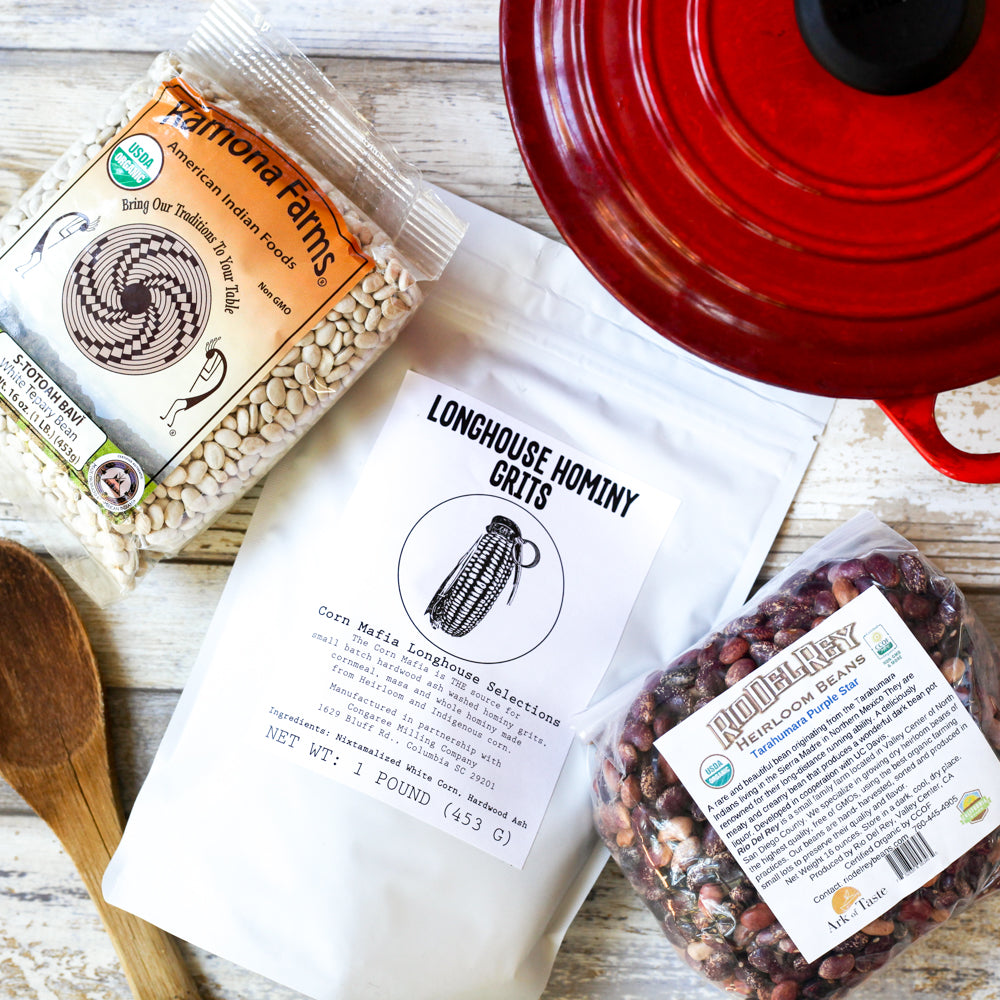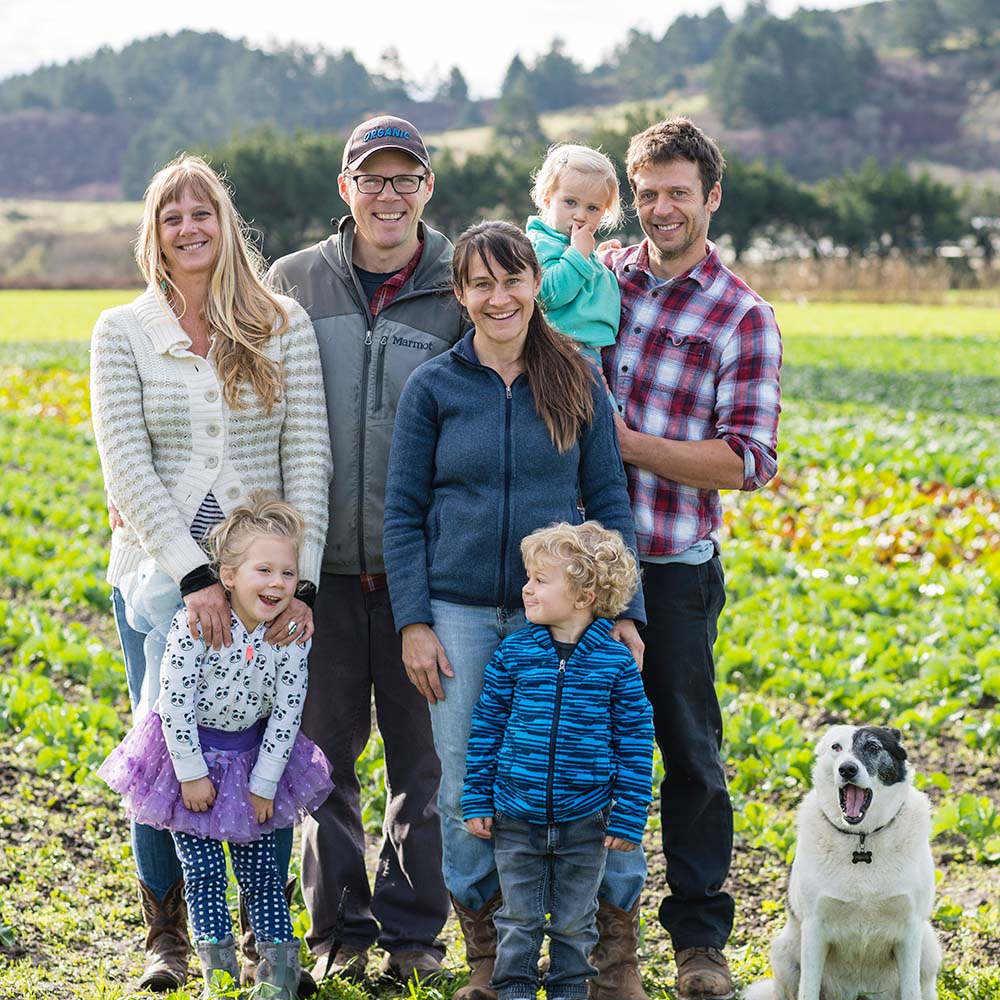10.99 FLAT RATE SHIPPING
10.99 FLAT RATE SHIPPING
SHOP

May Heirloom Bean & Grain Club
April 26, 2021 5 min read
The May Heirloom Bean and Grain Box is our best box yet! We are thrilled to introduce you to Rio Del Rey and their certified organic Rio Zape heirloom bean in addition to the impossible to find organic sorghum from Kandarian Organic Farms.

Family Size Box
The family size box contains certified organic Rio Zape beans from Rio Del Rey, Cranberry Beans by Rancho Gordo, Organic Black Tepary Beans by Ramona Farms, Organic Yellow Sunshine Lentils from Chili Smith and Organic Sorghum from Kandarian Organic Farms.
Small Box
The small box contains certified organic Rio Zape beans from Rio Del Rey, Cranberry Beans by Rancho Gordo and Organic Sorghum from Kandarian Organic Farms.

RIO ZAPE BEANS
Beloved by chefs and revered as "the noblest bean" by The Washington Post, this 100% organic heirloom bean club exclusive comes to us from family owned Rio Del Rey Farms in sunny California. It will blow your mind as a refried bean (as featured in Food & Wine Magazine), and you'll be the toast of the BBQ if you douse it with some mole sauce and serve instead of ho hum baked beans.

The Rio Zape is a very special bean, so special it's in the Slow Food Ark of Taste! Rumor has it that the bean was unearthed in the ruins of the Anasazi cliff–dwelling people in the American southwest. It is similar to the popular pinto bean but way more tasty, and is purple with dark burgundy slashes. The Rio Zape gives off a delicious dark gravy and has a creamy texture and a complex flavor with a hint of chocolate. It makes an excellent refried bean that is so simple to make it can hardly be called a recipe. The chocolate notes of the bean are really highlighted in this incredible Rio Zape with Toasted Chili Sauce recipe from Food52.

ABOUT THE FARMER
If you've never heard of Rio Del Rey Farms and Mikes beautiful 100% organic heirloom beans, it's probably because they aren't sold in stores and they're really hard to get your hands on.
Mike is a lifelong champion of sustainability with a sophisticated palette. After cooking up a batch of Rio Zape he turned his full attention to preserving rare heirloom beans a decade ago. He has been tasting, testing, growing beans ever since.
ORGANIC WHITE SORGHUM
This gluten free grain is a versatile alternative to other whole grains with a dense chewy texture similar to wheat berries and a delicious nutty taste. It can be popped like popcorn or used in everything from risotto to pilaf. Soghum is popular in Asian and African cuisine but it's just starting to catch on in the US. This earth friendly crop doesn't require as much water as other grains but delivers on nutritional density with high fiber, protein, Vitamin B and Magnesium and Iron.
Sorghum but it cooks very similar to other whole grains. To cook it stovetop combine 1 cup of grain with 1 cup of liquid (water or broth) and bring to a boil, cover and reduce to a simmer for one hour. Let it rest for 5 minutes, drain any access liquid and fluff with a fork. This grain simply will always remain toothy in texture no matter how long you cook it. The possibilities with this are endless but we love this Mushroom Miso Grain Bowl and this delicious Spiced Butternut Squash and Sorghum Salad.

One of the more fun things to do with Sorghum is to pop it just like popcorn but much smaller and cuter. You can do it stovetop (go in small batches and pay close attention so that it doesnt burn) or put it in a paper lunch bag, lay flat in the microwave and set it for 3 minutes, pause at 90 seconds, shake the bag and then continue for another 30 seconds and shake the bag before returning for another 10-30 seconds. When it's done, spray or lightly coat with the oil of your choice (we like olive oil or cocunt oil) and sprinkle with the seasoning of your choice. We love it with the Lemon Thyme Salt.

ABOUT THE FARMER
When it comes to ancient grains and farming, Larry Kandarian is legendary. Meeting Larry at the Santa Monica farmers market feels like meeting an agricultural prophet. He can talk to you all day about varieties of beans and grains you've never heard of and how going beyond just organic to fully sustainable and regenerative farming creates better tasting food. His deeply weathered hands from over 50 years working in the fields, let you know that he's the real deal. Unlike others, Larry doesn't just own a farm, he is a true farmer. He is passionate about growing better tasting food that is also better for us and the planet. His incredibly diverse array of grains, legumes, herbs and spices grown in Los Osos, California are all carefully chosen heirloom varieties that work together to create a self-sustaining eco-system that requires no fertilizer, pesticides or weed killers. All of this leads to better soil health, and when you grow food in better soil it just tastes better. You can listen to Larry on a podcast by Consumed here.

CRANBERRY BEANS
This versatile and velvety, thin-skinned bean produces a rich, indulgent bean broth. While Cranberry is an odd name for a lovely, versatile bean which has been bred around the world to become Madeira, Borlotti, Tounges of Fire, Wren’s Egg and more. With so many names, it's clear it can be used in almost any dish that beans are needed for.
Try this in a traditional Pasta e Fagioli where the luxurious bean sauce the cranberry gives off really shines. It's also a great bean to use in any soup. We love this Cranberry Bean and Kale Soup from the New York Times.
ABOUT RANCHO GORDO
Rancho Gordo beans by Steve Sando are kinda a big deal. It started as a hobby of growing heirloom beans and figuring out different ways to cook them and quickly led to farmer’s markets. When the people started loving all the varieties he grew, as much as Steve did, he knew he was onto something good. Read More...
BLACK TEPARY BEANS

These Non-GMO heirloom black beans are a very rare variety of the Native American tepary bean. They are a delicious and more nutritious alternative to traditional black beans. Born of an ancient tradition of separating the black seeds before planting the white or brown teparies, the black seeds were selected, planted, grown, and harvested over several years to bring out the hidden traits of this unique tepary bean. The s-chuuk bavi (black tepary bean) has a firm, meaty texture and a distinctive flavor with a hint of lime that makes it perfect for Mexican cuisine. Try them in replace of black beans in all of your favorite recipes.
Tepary beans are the original superfood of the Sonoran Desert having sustained Native American people for countless generations. Ramona Farms shares with us their traditional foods grown on the ancestral lands of the Akimel O'Odham (Gila River Pima) tribe in Arizona's Sonora Desert. An ingredient in the Slow Food Ark of Taste, the tepary bean is believed to be the world’s most drought tolerant bean, and higher in fiber and protein than most other beans with a low glycemic index and superior taste.
Read more about Ramona Farms and the tepary bean here.

GOLDEN SUNSHINE LENTILS
These beautiful yellow lentils are grown organically in Montana on family farms. They are fresher and much tastier than what you'll find in the supermarket. The buttery texture makes them perfect for making classic yellow dahl. They're also amazing in salads and soups and we are head over heals for this coconut curried golden lentil recipe.
Recent Articles
About Us
Foodocracy is dedicated to creating a more sustainable and independent food system. We support small, independent farms across the nation.
Get impossible to find beans and grains shipped direct to your doorstep each month from small family farms.
We support small, family owned farms across the nation. Did you know that farmers only make an average of 10 cents on every dollar you spend at the supermarket? Working directly with farms and not middle men ensures that more money goes back to the people actually growning your food.
Get 10% Off
Sign up for delicious recipes and special offers.
**Regularly priced items only.





